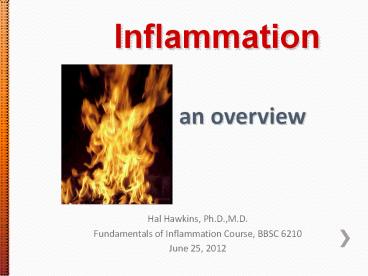Inflammation an overview - PowerPoint PPT Presentation
1 / 60
Title:
Inflammation an overview
Description:
Title: s on inflammation Subject: acute inflammation Author: Hal Hawkins Keywords: vessels, inflammation Description: For medical school lectures on acute ... – PowerPoint PPT presentation
Number of Views:154
Avg rating:3.0/5.0
Title: Inflammation an overview
1
Inflammation an overview
- Hal Hawkins, Ph.D.,M.D.
- Fundamentals of Inflammation Course, BBSC 6210
- June 25, 2012
2
ACUTE INFLAMMATION includes
- Vasodilation and vascular leakage
- Cellular
- recruitment
- activation
- functions
- tissue Injury
3
MICROVASCULAR ENDOTHELIAL CELL
4
Histamine
5
(No Transcript)
6
(No Transcript)
7
Leakage of venules marked with colloidal
carbon(India ink) after application of histamine
8
Triple Response of Lewis
9
(No Transcript)
10
Vascular reactions account for the classical
cardinal signs of inflammation
- Tumor edema due to plasma leakage
- Rubor dilation of arterioles and engorgement of
microvasculature - Calor increased local temperature
- Dolor probably due to stretching and
prostaglandins
11
(No Transcript)
12
(No Transcript)
13
(No Transcript)
14
Time course of acute inflammation
15
Neutrophil Recruitment
- MARGINATION
- ADHERENCE
- EMIGRATION AND CHEMOTAXIS
16
Julius Cohnheim, 1839-1884
17
Experiments of Cohnheim
- The tongue of the frog provides an
opportunity to see the microcirculation and the
movements of neutrophils.
18
OBSERVATIONS OF COHNHEIM (1882)
- With the slowing of blood flow in the dilated
venules leukocytes appear in the marginal stream
and tend to stick to the vessel walls. At first
the leukocytes stick momentarily and are then
displaced to be washed away by the blood stream.
19
more COHNHEIM
- As they begin to adhere more closely some
are pushed slowly along by the blood stream,
becoming flattened and elongated in the direction
of the flow so that they have the appearance of
blobs of jelly being pushed along over a sticky
surface.
20
more COHNHEIM
- Gradually some of the cells adhere more
firmly until even a relatively swift stream of
plasma and red corpuscles cannot dislodge them.
- With an adequate injury some of the
leukocytes sticking to the wall begin to make
their way through it by active movements, taking
2 to 12 minutes to do so.
21
(No Transcript)
22
Will this link work?http//www.youtube.com/watch
?vWEGGMaRX8f0
23
(No Transcript)
24
Selectins (responsible for rolling)
25
Integrins(essential for firm adhesion and
emigration)
26
Integrin activation
27
Armond Goldmans discovery of integrins
Armond Goldmans discovery of neutrophil integrins
28
(No Transcript)
29
And another one in color!
- http//www.youtube.com/watch?v9wxK6oLA5oc
30
And a third in diagram form
- http//www.youtube.com/watch?vDMvixApKzKs
31
Transient opening of intercellular junctions
32
(Neutrophil emigration does not produce vascular
leakage!)
(from Marchesi and Florey)
33
Neutrophil Activation
- Receptors (complement, IgG, etc.)
- PAF (platelet activating factor)
- Phospholipase ?
- Inositol triphosphate ? Ca release
- Diacylglycerol ? Protein kinase C
34
Platelet-Activating Factor, PAF
35
Chemotaxis Migration toward higher concentration
36
http//www.youtube.com/watch?vZUUfdP87Ssg
http//www.youtube.com/watch?vZUUfdP87Ssg
37
Important chemotactic factors
- Complement fragment C5a
- Bacterial formylated peptides
- Arachidonic acid products,
- e.g. Leukotriene B4
- Cytokines called chemokines, e.g. IL-8
38
Relative potencies of chemotactic factors
39
Priorities among chemotactic factors
40
COMPLEMENTa central mediator of inflammation
and immunity
41
Complement components
42
(No Transcript)
43
Neutrophil Functions
- PHAGOCYTOSIS
- FUSION OF GRANULES
- BACTERIAL KILLING
44
Opsonization by complementstimulates phagocytosis
45
Phagocytosis
46
The Neutrophil Oxidative Burst
47
Bacterial Killing
- O2-, superoxide
- H2O2, peroxide
- HOCl, hypochlorous acid ?
- OH, hydroxyl radical
- Acid hydrolases (enzymes)
- Bactericidal proteins, defensins, lactoferrin,
lysozyme
48
Pneumonia
49
MEDIATORS of INFLAMMATION
- Plasma proteases, e.g. complement
- Vasoactive amines, e.g. histamine
- Platelet-activating factor PAF
- Arachidonic acid metabolites, e.g. prostaglandin
E3 - Reactive oxygen and nitrogen species
- Cytokines and chemokines, e.g. IL-8
- Neuropeptides and endothelin
50
(No Transcript)
51
Prostaglandins and leukotrienes
- Products of arachidonic acid metabolism
- Potent vasodilators/vasoconstrictors
- Cyclo-oxygenase (COX), needed for prostaglandin
synthesis, is inhibited by aspirin and selective
COX2 inhibitors including the notorious Vioxx - Important in fever and pain
- Lipoxygenase leads to leukotrienes,
proinflammatory lipids active in asthma
52
Inflammatory Tissue Injury
- O2-, superoxide
- H2O2, peroxide
- HOCl, hypochlorous acid
- OH, hydroxyl radical
- ONOO-, peroxynitrite
- (all reactive oxygen and nitrogen species)
- Lysosomal neutral hydrolases
53
Neutrophil apoptosis
- Follows emigration and phagocytosis
- Minimizes tissue injury
54
Regulation of neutrophil apoptosis
- DELAY
- GM-CSF G-CSF
- LPS, IL-1, IL-2
- IFN-gamma
- STIMULATE
- IL-6
- Phagocytosis
- Oxidative burst
55
Neutrophil apoptosis is the key to prevention of
tissue injury.
- Cellular contents may not be released
- Clearance by macrophages stimulates activation of
macrophages to secrete factors favoring wound
healing
56
Whats new?
- Recognition of Pathogen Activated Molecular
Pathways (PAMPs) including Toll Like Receptors
(TLRs) and Damage Activated Molecular Pathways
(DAMPs) (together sometimes called Alarmins). - TLRs stimulate release of multiple
pro-inflammatory peptides. - DAMPs lead to assembly of inflammasomes,
activation of caspase-1, and production of
IL-1beta.
57
(No Transcript)
58
(No Transcript)
59
(No Transcript)
60
(No Transcript)































